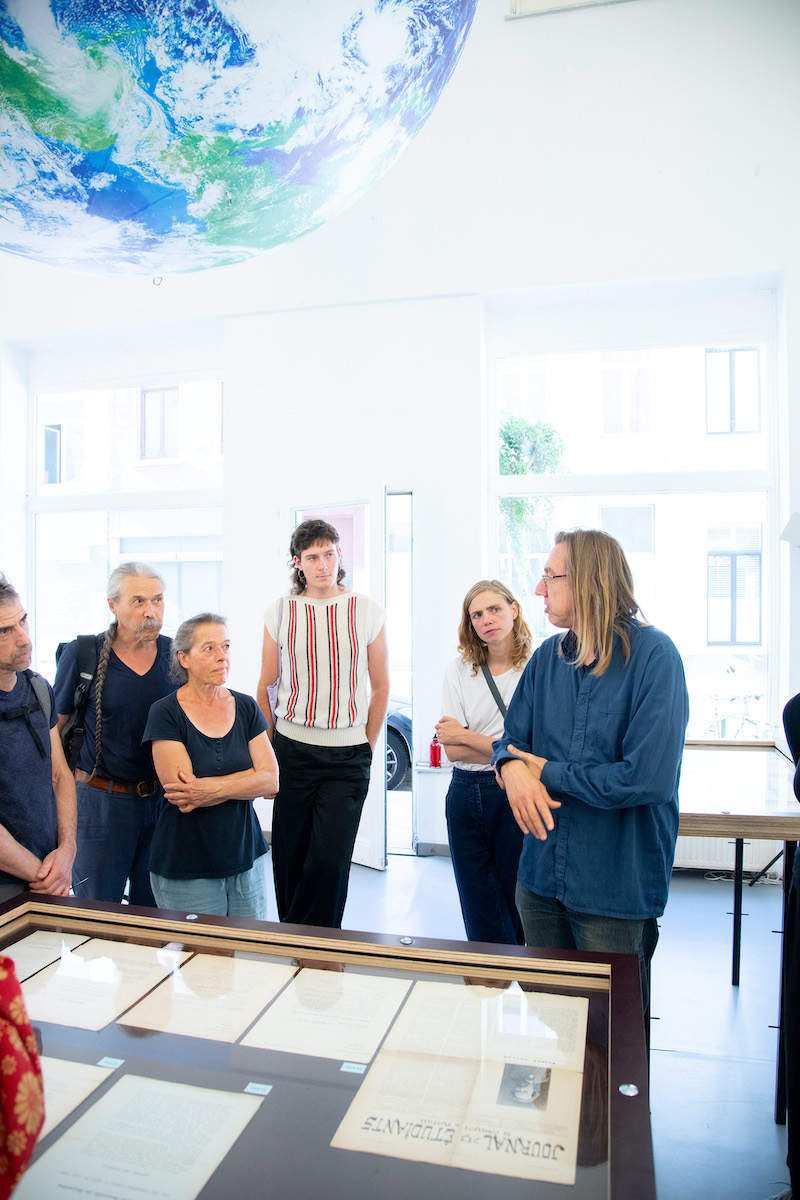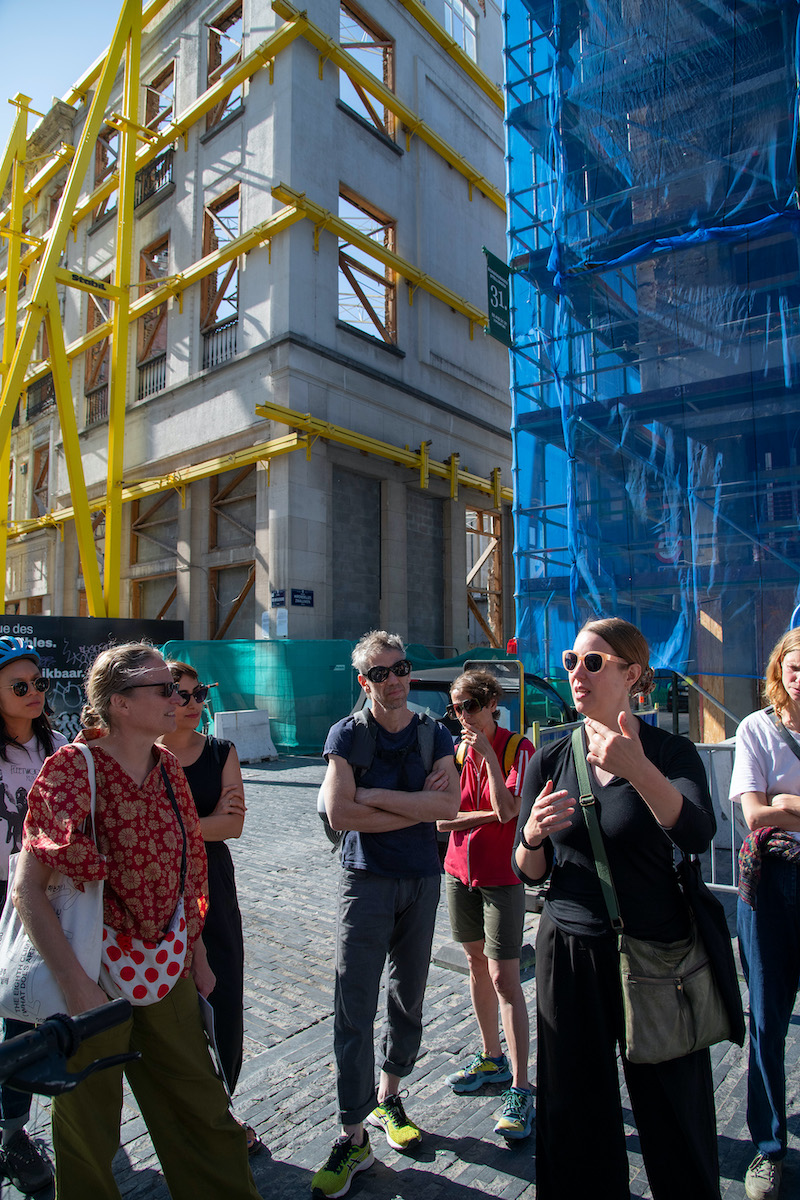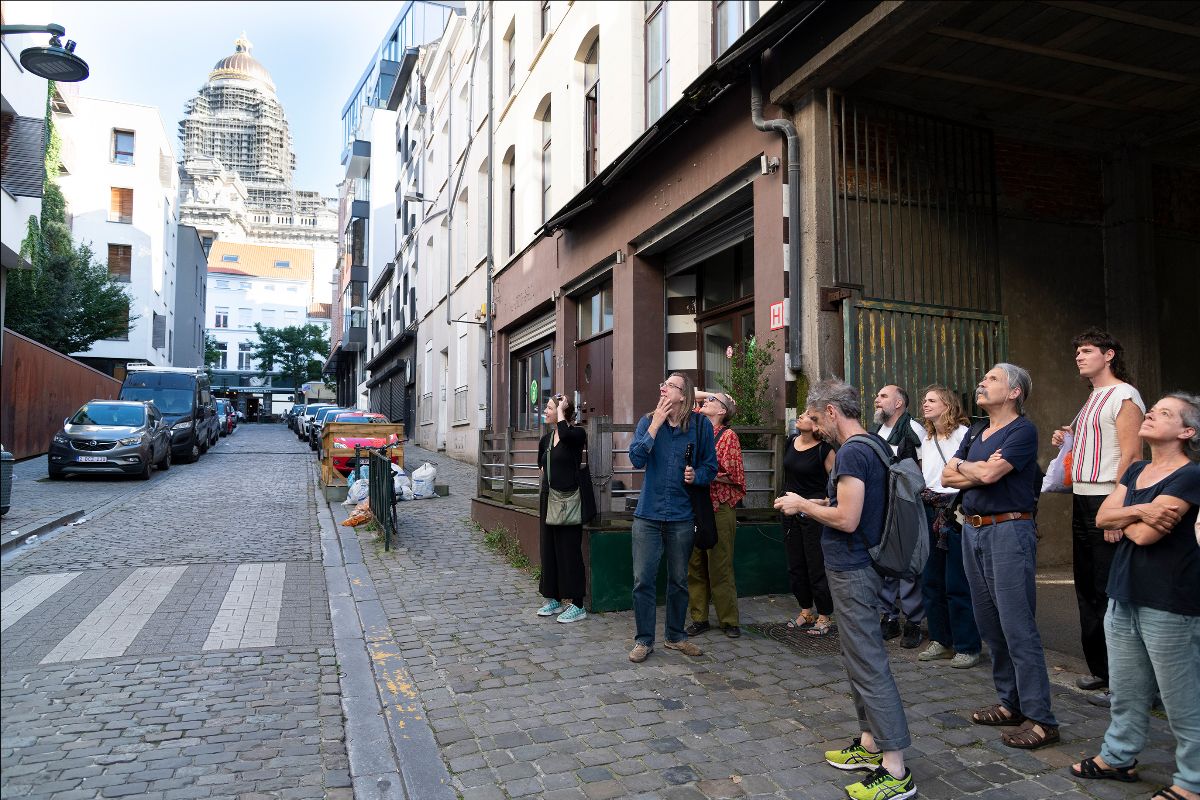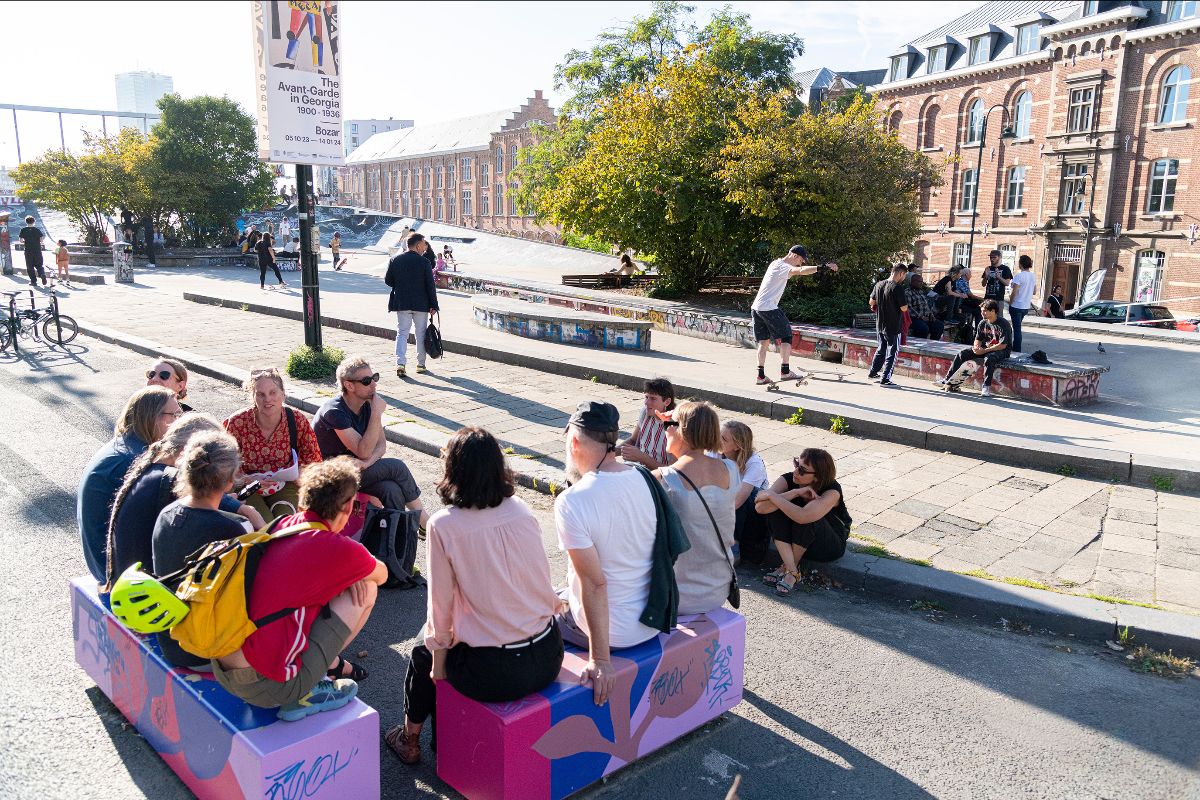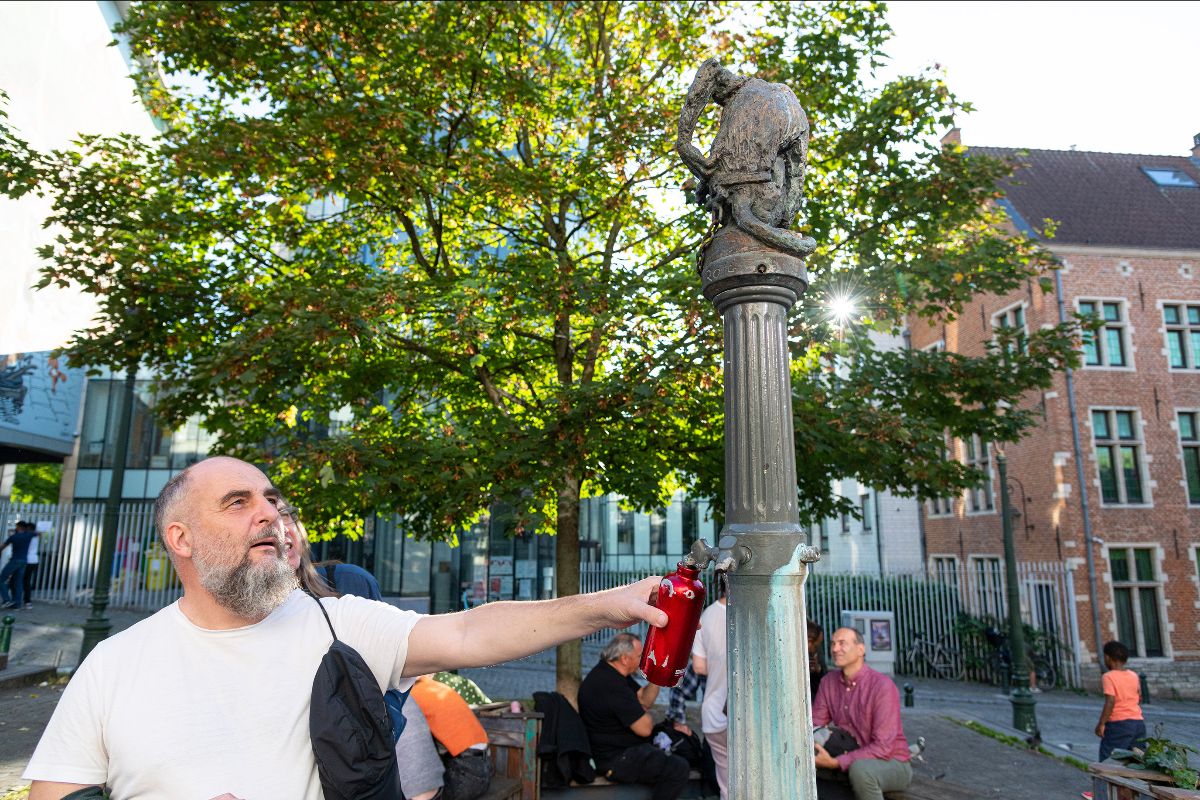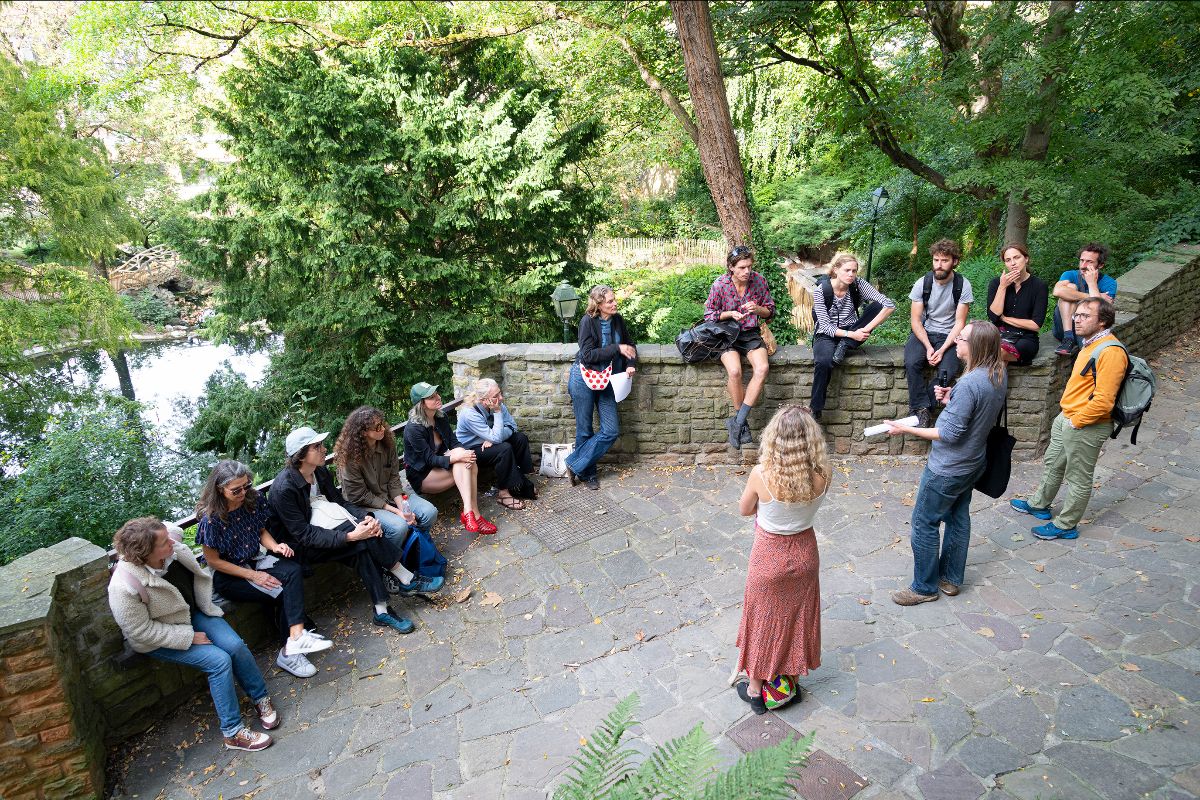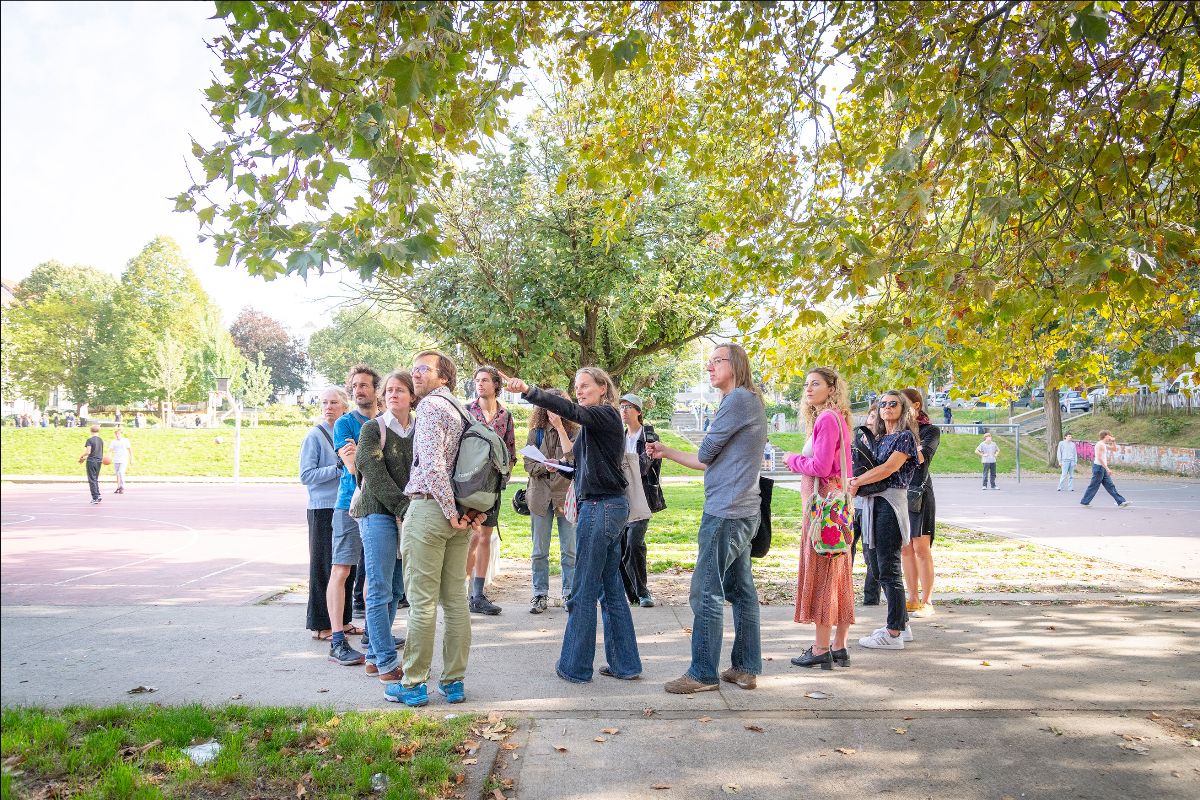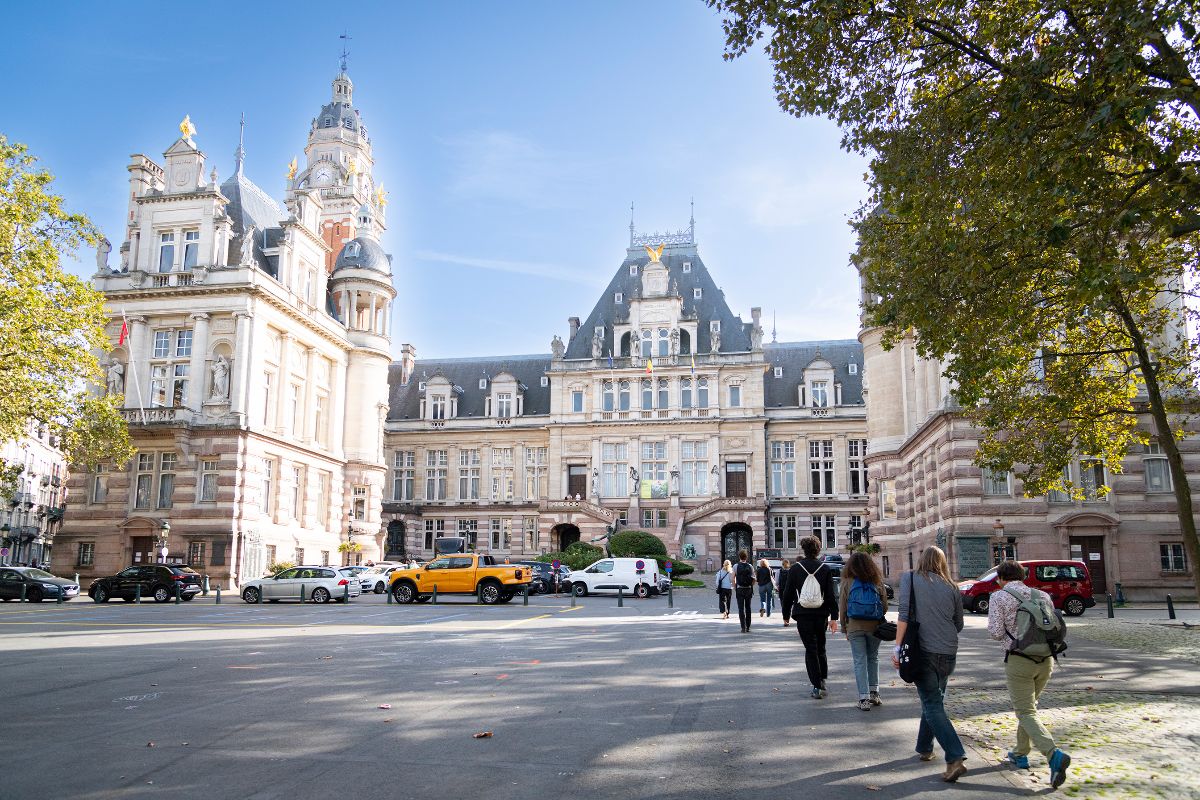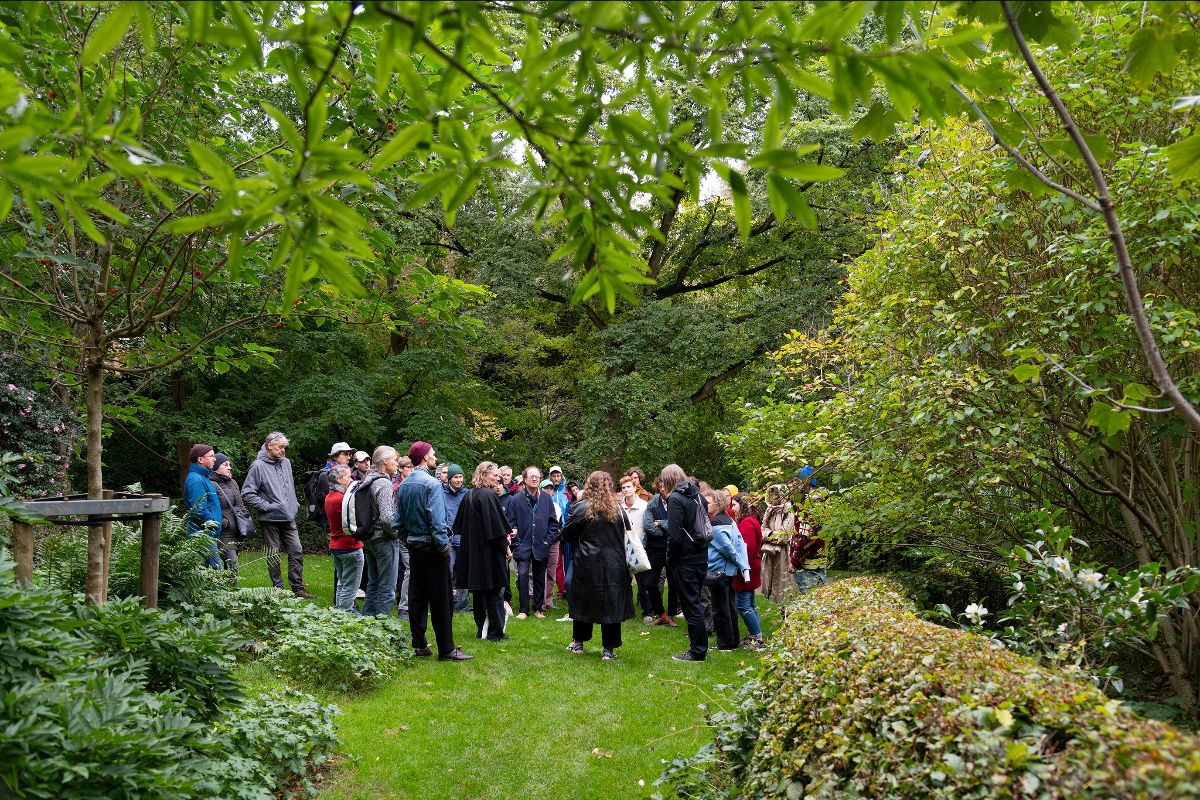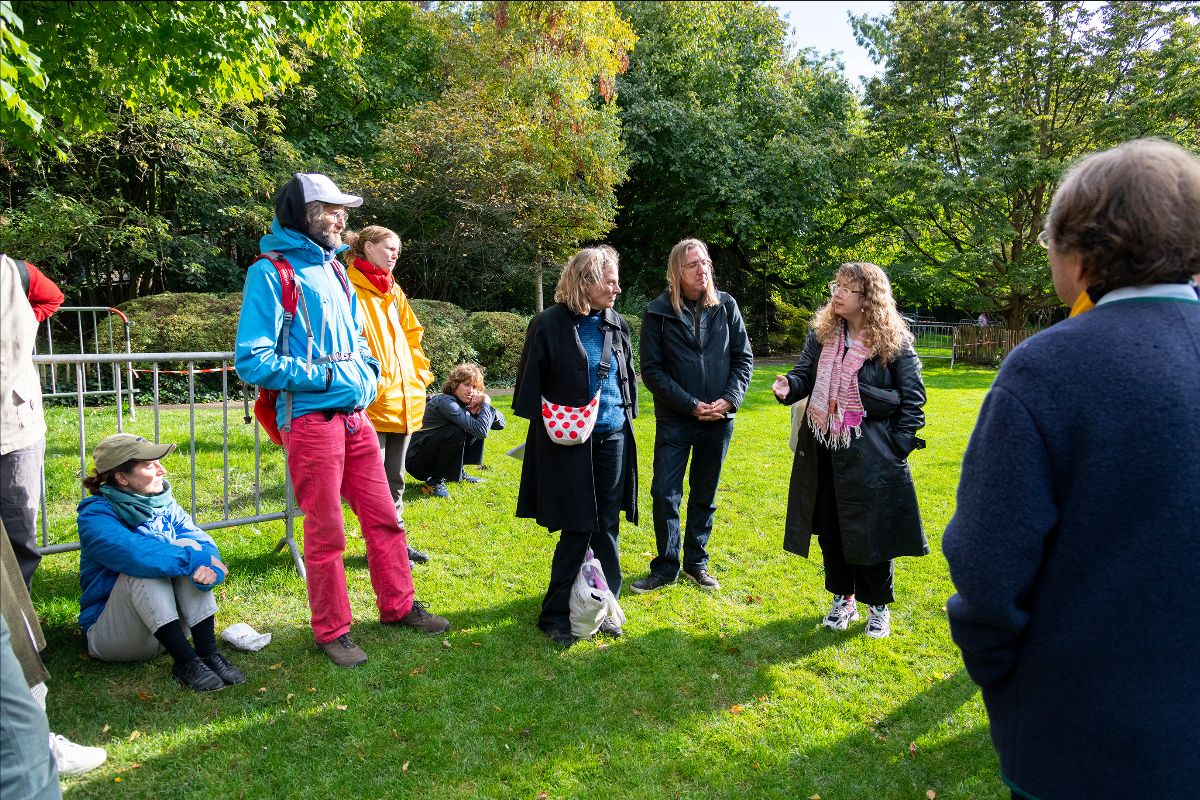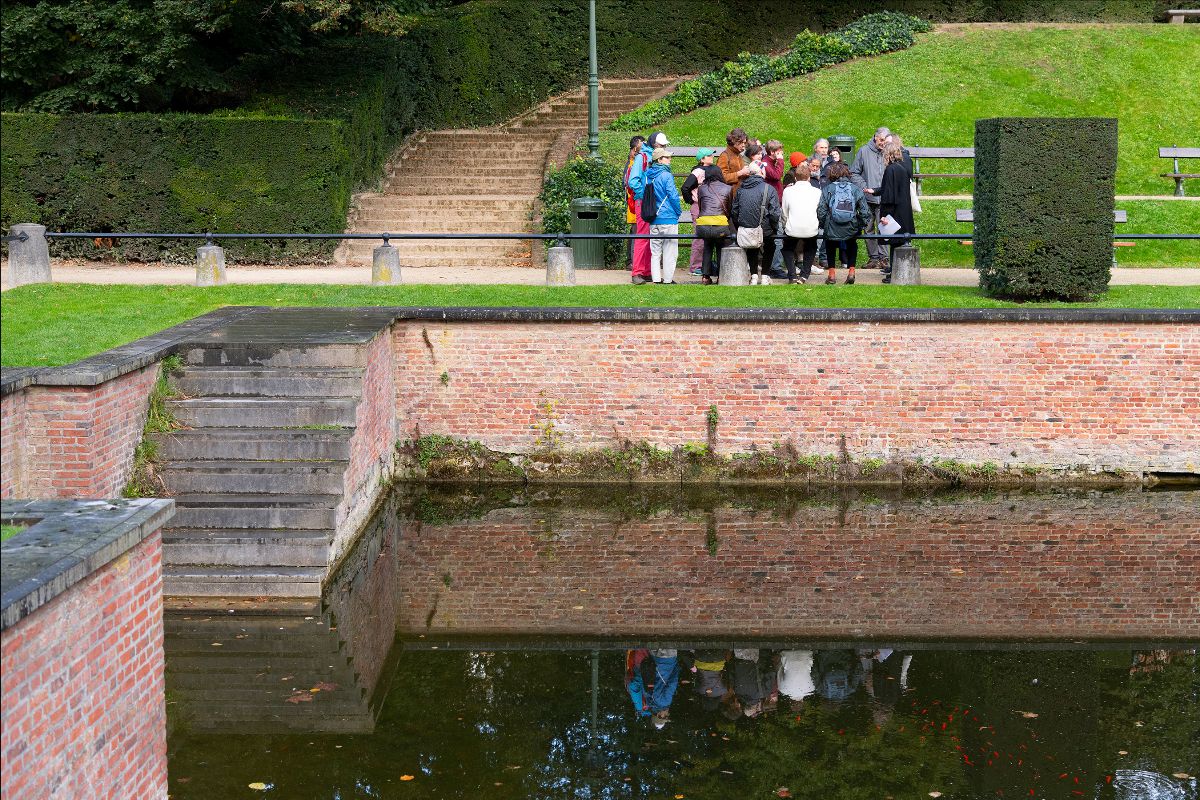7 Walks (learning through the soles of our feet)
Solo exhibition by Vermeir & Heiremans at n0dine, Brussels
22/09 September – 15/10/2023
Opening: 21/09/2023
Vermeir & Heiremans in collaboration with David Aubin, Margot Elmer, Emily Rosamond.
7 Walks (Learning Through the Soles of our Feet) is a co-production of nadine vzw and Jubilee vzw. Many thanks to the Service des Archives, patrimoine et réserve précieuse of the Université libre de Bruxelles. Supported by the Flemish Community.
Three public walks on 1, 8, 15/10/2023, 14-18h (for details, see below):
01/10/2023: WALK #01 – Brussels city centre
The geographer who didn’t like maps
08/10/2023: WALK #02_Saint-Gilles
A source for value distribution? From a cooperative for drinking water to an Rationalist Orphanage
15/10/2023: WALK #03_Ixelles
Little rivers together make big streams. The world as a work of art
Learning Through the Soles of our Feet
7 Walks is an artistic research trajectory in collaboration with guest walkers and participants. Using walking as a public research method and developing a direct relation with the natural or urban environment, the project aims to connect the ecology of the arts with a natural common good – water.
Vermeir & Heiremans develop three new walks in Brussels for nadine, initiating a dialogue on concepts such as ownership, public goods and governance, and exploring forms of value redistribution and mutualism. At the same time, they examine cartography from an alternative pedagogical perspective.
The walks activate the archival documents that the artists present in nadine’s exhibition space. These documents are a generous loan from the Service des Archives, patrimoine et réserve précieuse of the Université libre de Bruxelles. They highlight the role of anarchist and geographer Élisée Reclus (1830-1905) within the Université Nouvelle and the Institut des Hautes Etudes. These institutions were founded in Brussels in 1894 by progressive thinkers and dissident ULB professors after Reclus’ invitation to teach geography at the Université libre was cancelled for fear of reputational damage in connection with Reclus’ anarchist views and sympathies.
The self-organized Université Nouvelle became an international meeting point where Élisée Reclus, as well as neo-impressionist artists, writers, lawyers, activists and progressive politicians taught. The Institut des Hautes Etudes offered free adult education with the emancipation of workers and students in mind. In this context Reclus set up the Institut Géographique.
Geography takes up a central role in alternative learning, with walking as a didactic method. The great tradition of anarchist education swears by the axiom that the best learning happens… through the Soles of our Feet. Anarchist geography saw 2D maps as a means of creating dependent subjects rather than empowered citizens. Reclus did not like 2D maps either, instead his teaching started from the observation of the nearest stream. Based on his book Histoire d’un ruisseau (1869) he practiced an intuitive geography, one that was in direct contact with its environment.
Vermeir & Heiremans gladly take up this advice in their walks to observe the Brussels’ waters: the sources, drinking fountains, lakes and the invisibilized vaulted rivers.
Next to historical documents the artists have installed a giant globe hanging from the ceiling of the exhibition space, with a printed image of the earth derived from powerful NASA satellite data. We see the earth and its fragile envelop, the atmosphere, showing us weather patterns from space.
Creating a giant globe was one of the dreams Reclus wanted to realize: a realistic representation of the world, devoid of boundaries, meridians and abstract cartographic symbols. According to Reclus, “the globe outdoes the map by nature of its truthfulness: it represents the planet in its true structure, it varies exactly according to the real contours, whereas maps, increasingly false as they are applied to greater parts of the planetary surface, can only deceive the viewer regarding the relative dimensions of different regions while on the curvature of an artificial globe it is impossible to err with regard to the relative area of the various terrestrial entities”[1]. Flat 2D maps deform countries and continents due to their chosen projections. Those maps reflect the power of the person or state who commissioned the map. Therefore, Reclus’ Institut Géographique created small globes and 3D maps for schools promoting alternative education.
Today we can assemble the wealth of photographic information on a variety of reality maps and globes. One can retrace these maps and globes to one picture that revolutionized our view of the world. In 1972 NASA distributed AS-17-148-22727, the first photograph that showed the complete earth, emancipating itself from earlier cartographic conventions, or so it seemed. In fact, the picture has been re-oriented by NASA. The original picture shows the south side up, and the continents ‘upside-down’. NASA also cut out the globe from the black cosmos and re-entered it in close-up in the middle of the image.[2]
Why did NASA re-orient the globe with north on top? Even Élisée Reclus represented the earth in that way. It is a cartographic reasoning. In order to find oneself on the earth, north is placed upwards, and so the map, as a powerful concept, is re-surfacing again. Despite itself, AS-17-148-22727 became a map. Cartography seems so ingrained in our brains. How can the world be made visible, as it is and not as we think it is? How can the cartographer disappear? How can the vast empty space of the cosmos be visible, and the fragile tiny earth in it?
To make the cartographer disappear was Reclus’ motivation to create a Great Globe at the scale of 1/100.000, resulting in a monumental object of 127,5 meters of diameter to be presented at the 1900 Paris World Fair. Reclus envisaged to appoint neo-impressionist artists to draw the color decoration for the enormous surface of the globe.[3] “The great symbolic power of that object, which was never realized, was an attempt to minimize as much as possible the dichotomy between the world and its representations, that is to make the world an artwork.”[4]
Reclus’ vision clearly merged art, geography and activism. A form of social geography in which one can act upon the world and be embedded in it, to (socially) reform it for all living beings. “The earth is infinitely beautiful, but for us to associate ourselves to its beauty, to glorify it by a respectful art, there is no other means but that of becoming free of instituting the decisive revolution against money and of ennobling the class-struggle by abolishing the classes themselves”.[5] Reclus warns us that ugliness is created by speculation and accumulation. The reason for that he saw in “the fact that everything can become private property.”[6]
Today the powerful NASA image has become a new type of map. Inside the virtual world of Earth 2, we rediscover the image as a geo-located Metaverse, in which a direct relation with where you are in the real world is created. Earth 2 is building “a pristine 1:1 scale digital replication of our planet Earth. Earth 2 is one of the most successful startups in history and has grown into the biggest Virtual Land Registry in the world with over 100 million tile land parcels sold.”[7]
In his short story ‘On Exactitude in Science’ (1946) Jorge Luis Borges describes the Cartographers Guilds who had struck a “Map of the Empire whose size was that of the Empire, and which coincided point for point with it”[8]. Later generations had allowed the map to fall in ruins. When in these 1:1 Metaverse Earths, the real earth and virtual earth are linked in the form of real estate parcels, and when intellectual, material and immaterial property converge, public space, the commons, movement and free speech might become severely restricted, opening up the possibility of the propertization of everything.[9]
The walks through Brussels question the dark side of all these forms of cartography as an infrastructure of power and surveillance, what occasionally becomes visible in the urban fabric. In these walks Vermeir & Heiremans address the possibility to co-create an emancipatory cartography, starting from artistic practices embedded in the landscape, a cartography that can generate new narratives, collaborations, mutualism and agency.
View the project booklet here, with and introduction, the full programme of the walks, and biographies of the invited specialists (PDF: less than 1 MB)
Footnotes
1. Reclus É., ‘Projet de construction d’un globe terrestre à l’échelle du cent-millième’, Paris, 1895, 3-4. in: Federico Ferretti, Pioneers of the History of Cartography: the Geneva map collection of Élisee Reclus and Charles Perron. Journal of Historical Geography, Elsevier, 2014, 43 (1), pp.85-95.
2. Gillet, A. AS17-148-22727 – Face à la Terre, Geogr. Helv., 70, 27–32, https://doi.org/10.5194/gh-70-27-2015, 2015.
3. Ferretti F., “Anarchism, geography and social art”, in C. Kosuch (ed.) Anarchist Avant-Garde, Amsterdam, Brill, 2019, 235-259, https://brill.com/view/book/edcoll/9789004410428/BP000013.xml, p15
4. Ibid.
5. Reclus É, ‘L’Art et le peuple’ (1904), in: F. Ferretti, “Anarchism, geography and social art”, in C. Kosuch (ed.) Anarchist Avant-Garde, Amsterdam, Brill, 2019, 235-259, https://brill.com/view/book/edcoll/9789004410428/BP000013.xml, p13
6. Reclus É., ‘Du Sentiment de la nature dans les sociétés modernes’ (1866), in: F. Ferretti, “Anarchism, geography and social art”, in C. Kosuch (ed.) Anarchist Avant-Garde, Amsterdam, Brill, 2019, 235-259, https://brill.com/view/book/edcoll/9789004410428/BP000013.xml, p13
7. https://earth2.io
8. Borges J.L., On Exactitude in Science, Collected Fictions, translated by Andrew Hurley
9. Vermeir & Heiremans, ‘Volatile properties: A Modest Proposal revisited’, Finance and Society 2023, 9(3): p75-90.
01/10/2023: WALK #01 – Brussels city centre
The geographer who didn’t like maps
We question walking as an experiential educational and artistic method as practised by the anarchist and geographer Elisée Reclus, as well as his attempts at appropriating maps as a tool of social geography instead of power and surveillance.
The walk starts from exhibition space n0dine where we highlight a number of documents we collected on Reclus, the Université Nouvelle and the Institut des Hautes Etudes. These institutions were founded by progressive thinkers and dissident professors after Reclus’ invitation to teach geography at the Université Libre was cancelled for fear of his anarchist sympathies.
We then look for the nearest river, the Zenne which, after many proposals and plans, was finally vaulted, and for which working-class neighbourhoods had to give way to stately avenues from 1865 onwards. We then walk past surprising places where historical characters lived or worked, including artists, writers, lawyers, geographers, politicians,…who played a decisive role in the creation and development of the Université Nouvelle. In the process they’ve put a social-emancipatory role of geography, art and education on the map.
practical:
Sunday 1 October 2023, 14-18h
Starting point: n0dine, Lakensestraat 105
Guest walker: Emily Rosamond
Reservations: loes@nadine.be
Language: EN
08/10/2023: WALK #02_Saint-Gilles
A source for value distribution? From a cooperative for drinking water to an Rationalist Orphanage
We ask whether alternative forms of ownership could contribute to a more equal distribution of social value. We first explore the hidden sources of Saint-Gilles. Brussels city monopolised drinking water from 1858. As a result of a legal dispute, nine peripheral municipalities created a cooperative in 1891 to distribute the water coming from the municipality of Spontin. A few monuments remind us of this event.
This walk explores the method of direct observation and critical forms of pedagogy as well, where we meet some protagonists that were involved in both the creation of the Université Nouvelle, as in the founding of the Cooperative of the Rationalist Orphanage in 1893. This orphanage was run as an experimental school from 1900 by the feminist Isabelle Gatti de Gamond. She used the experimental maps of Reclus and walking as a method was applied there. The original building still stands near today’s Duden Park and Forest Park.
From 1875, the existing urbanist map was wiped out, along with some brand-new workers’ quarters. Workers were relocated there due to the vaulting of the Zenne in the city centre, but they had to make way for a park lined with villas, promoted for its fresh air workers could breathe there.
practical:
Sunday 8 October, 14-18h
Starting point: Parvis de Sint-Gilles-Metro entrance on Parvis
Guest walker: David Aubin
Reservations: loes@nadine.be
Language: EN
15/10/2023: WALK #03_ Ixelles
Little rivers together make big streams, the world as a work of art
This walk focuses on the role of art in society. We walk to the source of the vaulted Maelbeek, near La Cambre Abbey, where Henry Van de Velde founded his Nationale Hoogere School voor Sierkunst in 1926. He started his career influenced by anarchist writings such as Proudhon’s book Du principe de l’art et de sa destination sociale (1865).
The question of the role of art was as alive then as it is today. An international meeting point were this question was addressed was the Université Nouvelle in Brussels, where Elisée Reclus, as well as neo-impressionist artists like Théo Van Rysselberghe, writers like Emile Verhaeren, and also Van de Velde taught.
Questions around the autonomy of the artist, the political instrumentalisation of artistic practice, the question of whether new forms of expression in art could be the starting point for a renewal of society were all on the agenda. One of the basic ideas of anarchism, the importance of individual freedom in relation to solidarity was expressed by the neo-impressionists’ divisionism, which was based on science. In the pointillist technique, each point retains its colour and individuality, but to the eye they merge harmoniously.
For Elisée Reclus, the true work of art was the world itself, and in his vision of social geography and radical education, with its focus on physical labour and a direct relationship with the environment, these neo-impressionist artists were social reformers whom he engaged for the giant globes and relief maps he wanted to realise in order to reduce the gap between the world and its representations.
Elisée Reclus lived close by the lakes of Ixelles, and we just have to cross over to the Abdijstraat where there are still some studios of some of these artists, grouped as Les XX(1883-1893) and later as La Libre Esthétique (1894-1914). The group, of which Anna Boch was the only female artist, played an important role in avant-garde art in Europe.
The magazine L’Art Moderne, which promoted the social art of these artists, took a position against the l’art pour l’art movement. Political agitation, good taste and intellect came together to educate the worker, both in the free adult education of the Institut des Hautes Etudes, the Extension Universitaire, the Section d’Art of the Brussels Workers’ Party in Horta’s Maison du Peuple/Volkshuis, and in the Maison d’Art of the socialist aesthete and jurist Edmond Picard.
practical:
Sunday 15 October, 14-18h
Starting point: Ten Bosch Park, meeting spot at the park entrance on the left side of the India Embassy, Vleurgatsesteenweg 217, Ixelles (closest tram 8 or 93 Abbaye, Avenue Louise)
Guest walkers: Tatiana Debroux, Margot Elmer
Reservations: loes@nadine.be
Language: EN
BIOGRAPHIES
David Aubin is professor of political science at the School of Political and Social Sciences at the University of Louvain-la-Neuve. He teaches courses on public policy analysis and evaluation. He is also conducting research on the comparative analysis of environmental policy, and the use of expertise and knowledge in the policy process.
Tatiana Debroux is a geographer and Doctor of Science at the Université libre de Bruxelles (ULB) and Vrije Universiteit Brussel (VUB). Her research focuses mainly on the spatialities of the artistic world, but she is also working on literary representations of Brussels and the development of a historical mapping tool. Since 2020, she has been editor-in-chief of the journal Brussels Studies.
Margot Elmer graduated in History at ULB Brussels and in Advanced Master in Management at Solvay Brussels School. Elmer is currently PhD researcher in History at the European University Institute in Firenze, where she is finishing her thesis on the Université Nouvelle de Bruxelles (1894-1919).
Emily Rosamond is a visual artist and senior lecturer at Visual Cultures in Goldsmiths University London. In 2021 she joined the editorial team of the Finance and Society Journal. Her research explores unexpected connections between theories of financialisation, literary character, contemporary art, performance and algorithmic governmentality. She is currently preparing the publication of ‘Reputation Warfare’, her book on value creation in digital environments through public image and reputation.
